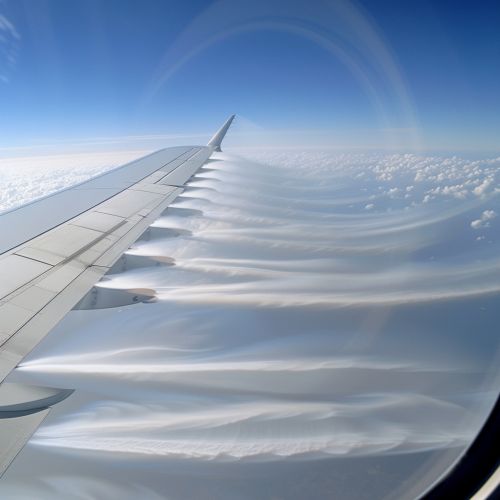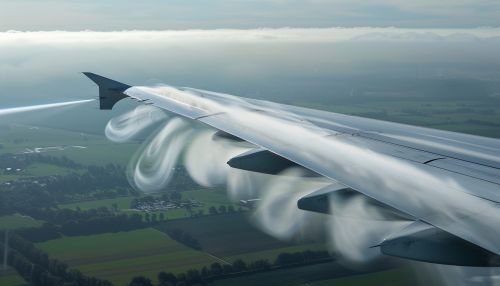Coanda Effect: Difference between revisions
(Created page with "== Introduction == The Coandă effect is a phenomenon in fluid dynamics where a jet flow attaches itself to a nearby surface and follows its contour. This effect is named after the Romanian aerodynamics pioneer Henri Coandă, who first observed it in 1910. The Coandă effect has significant implications in various fields such as aerodynamics, hydrodynamics, and engineering, influencing the design of aircraft, watercraft, and various fluidic devices. == Historical Backg...") |
No edit summary |
||
| Line 57: | Line 57: | ||
The Coandă effect is also used in various industrial applications, such as in the design of fluidic devices, air conditioning systems, and firefighting equipment. In fluidic devices, the effect is harnessed to control the flow of fluids without the need for moving parts, leading to more reliable and maintenance-free systems. | The Coandă effect is also used in various industrial applications, such as in the design of fluidic devices, air conditioning systems, and firefighting equipment. In fluidic devices, the effect is harnessed to control the flow of fluids without the need for moving parts, leading to more reliable and maintenance-free systems. | ||
[[Image:Detail-92327.jpg|thumb|center|An aircraft wing demonstrating the Coandă effect with airflow visualization.|class=only_on_mobile]] | |||
[[Image:Detail-92328.jpg|thumb|center|An aircraft wing demonstrating the Coandă effect with airflow visualization.|class=only_on_desktop]] | |||
== Experimental Studies == | == Experimental Studies == | ||
Latest revision as of 00:04, 15 June 2024
Introduction
The Coandă effect is a phenomenon in fluid dynamics where a jet flow attaches itself to a nearby surface and follows its contour. This effect is named after the Romanian aerodynamics pioneer Henri Coandă, who first observed it in 1910. The Coandă effect has significant implications in various fields such as aerodynamics, hydrodynamics, and engineering, influencing the design of aircraft, watercraft, and various fluidic devices.
Historical Background
Henri Coandă, while testing his Coandă-1910 aircraft, noticed that the exhaust gases from the engine tended to cling to the fuselage rather than dispersing straight back. This observation led to the identification and subsequent study of the Coandă effect. Despite initial skepticism, the phenomenon was later validated and has since been extensively studied and applied in various technological advancements.
Fundamental Principles
The Coandă effect is fundamentally a result of the interaction between a fluid jet and a nearby surface. When a jet is issued from a nozzle, it tends to remain attached to a convex surface due to a combination of the following factors:
Surface Tension and Adhesion
Surface tension and adhesion forces play a crucial role in the Coandă effect. The fluid molecules are attracted to the surface, causing the jet to adhere and follow the contour of the surface.
Pressure Differential
The pressure differential created by the fluid flow also contributes to the Coandă effect. As the fluid jet moves along the surface, it creates a low-pressure region between the jet and the surface, which further helps in maintaining the attachment.
Viscous Forces
Viscous forces within the fluid also contribute to the Coandă effect. The viscosity of the fluid creates a boundary layer that interacts with the surface, aiding in the attachment of the jet to the surface.
Mathematical Modeling
The Coandă effect can be described mathematically using the Navier-Stokes equations, which govern the motion of fluid substances. These equations take into account the viscosity, pressure, and velocity fields within the fluid. For a detailed analysis, computational fluid dynamics (CFD) simulations are often employed to model the behavior of fluid jets in the presence of surfaces.
The Navier-Stokes equations are a set of partial differential equations that describe the motion of viscous fluid substances. They are expressed as follows:
\[ \frac{\partial \mathbf{u}}{\partial t} + (\mathbf{u} \cdot \nabla) \mathbf{u} = -\frac{1}{\rho} \nabla p + \nu \nabla^2 \mathbf{u} + \mathbf{f} \]
where \(\mathbf{u}\) is the velocity field, \(t\) is time, \(\rho\) is the fluid density, \(p\) is the pressure, \(\nu\) is the kinematic viscosity, and \(\mathbf{f}\) represents external forces.
Boundary Layer Theory
Boundary layer theory is also essential in understanding the Coandă effect. The boundary layer is a thin region adjacent to the surface where viscous forces are significant. The behavior of the boundary layer, including its thickness and velocity profile, influences the attachment of the fluid jet to the surface.
Applications
The Coandă effect has numerous practical applications across various industries. Some of the most notable applications include:
Aerodynamics
In aerodynamics, the Coandă effect is utilized to enhance the lift and control of aircraft. By directing airflow over curved surfaces, such as wings or flaps, the Coandă effect can be used to increase lift and improve maneuverability. This principle is applied in the design of modern aircraft, including the use of Coandă flaps and blown flaps.
Hydrodynamics
In hydrodynamics, the Coandă effect is employed in the design of watercraft and fluidic devices. For example, in marine engineering, the effect is used to improve the efficiency of propellers and water jets by directing the flow of water along curved surfaces.
Industrial Applications
The Coandă effect is also used in various industrial applications, such as in the design of fluidic devices, air conditioning systems, and firefighting equipment. In fluidic devices, the effect is harnessed to control the flow of fluids without the need for moving parts, leading to more reliable and maintenance-free systems.


Experimental Studies
Numerous experimental studies have been conducted to investigate the Coandă effect and its various parameters. These studies often involve wind tunnel tests, water channel experiments, and advanced visualization techniques such as particle image velocimetry (PIV) and laser Doppler anemometry (LDA).
Wind Tunnel Tests
Wind tunnel tests are commonly used to study the Coandă effect in aerodynamics. By observing the behavior of airflow over curved surfaces in a controlled environment, researchers can gain insights into the factors influencing the attachment and detachment of the fluid jet.
Water Channel Experiments
Water channel experiments are used to study the Coandă effect in hydrodynamics. These experiments involve observing the behavior of water jets in the presence of curved surfaces, allowing researchers to analyze the influence of viscosity, surface tension, and pressure differentials.
Visualization Techniques
Advanced visualization techniques such as PIV and LDA are employed to study the Coandă effect in detail. These techniques allow researchers to capture high-resolution images of the fluid flow and measure velocity fields, providing valuable data for validating theoretical models and simulations.
Theoretical Advances
Recent theoretical advances have furthered our understanding of the Coandă effect. Researchers have developed new models and simulations to predict the behavior of fluid jets in complex geometries and under various flow conditions.
Computational Fluid Dynamics (CFD)
CFD simulations have become a crucial tool in studying the Coandă effect. By solving the Navier-Stokes equations numerically, CFD allows researchers to model the behavior of fluid jets in the presence of surfaces with high accuracy. These simulations provide detailed insights into the flow patterns, pressure distributions, and boundary layer characteristics.
Analytical Models
Analytical models have also been developed to describe the Coandă effect. These models often involve simplifying assumptions to make the problem more tractable, allowing researchers to derive closed-form solutions for specific cases. Analytical models are useful for gaining a fundamental understanding of the underlying physics and for validating numerical simulations.
Challenges and Limitations
Despite its numerous applications, the Coandă effect also presents several challenges and limitations. Understanding these limitations is crucial for effectively harnessing the phenomenon in practical applications.
Flow Separation
One of the main challenges associated with the Coandă effect is flow separation. Under certain conditions, the fluid jet may detach from the surface, leading to a loss of the desired effect. Factors such as high flow velocity, adverse pressure gradients, and surface roughness can contribute to flow separation.
Surface Curvature
The curvature of the surface also plays a significant role in the Coandă effect. While convex surfaces promote attachment, concave surfaces can lead to detachment and flow separation. Designing surfaces with the optimal curvature is essential for maximizing the benefits of the Coandă effect.
Viscosity and Reynolds Number
The viscosity of the fluid and the Reynolds number are critical parameters influencing the Coandă effect. High-viscosity fluids and low Reynolds numbers tend to enhance the attachment of the fluid jet to the surface, while low-viscosity fluids and high Reynolds numbers can lead to detachment.
Future Directions
The study of the Coandă effect continues to evolve, with ongoing research aimed at addressing the challenges and exploring new applications. Some of the future directions in this field include:
Advanced Materials
The development of advanced materials with tailored surface properties can enhance the Coandă effect. Materials with specific surface roughness, wettability, and adhesion characteristics can be engineered to optimize the attachment of fluid jets.
Microfluidics
The Coandă effect has significant potential in the field of microfluidics, where precise control of fluid flow is essential. By leveraging the Coandă effect, researchers can develop microfluidic devices with improved performance and reliability for applications in medical diagnostics, chemical analysis, and biological research.
Environmental Applications
The Coandă effect can also be applied to environmental engineering, such as in the design of efficient air and water purification systems. By directing fluid flows along specific paths, the Coandă effect can enhance the removal of contaminants and improve the overall efficiency of purification processes.
